Daniel Anglés-Alcázar
How DREAMS are made: Emulating Satellite Galaxy and Subhalo Populations with Diffusion Models and Point Clouds
Sep 04, 2024



Abstract:The connection between galaxies and their host dark matter (DM) halos is critical to our understanding of cosmology, galaxy formation, and DM physics. To maximize the return of upcoming cosmological surveys, we need an accurate way to model this complex relationship. Many techniques have been developed to model this connection, from Halo Occupation Distribution (HOD) to empirical and semi-analytic models to hydrodynamic. Hydrodynamic simulations can incorporate more detailed astrophysical processes but are computationally expensive; HODs, on the other hand, are computationally cheap but have limited accuracy. In this work, we present NeHOD, a generative framework based on variational diffusion model and Transformer, for painting galaxies/subhalos on top of DM with an accuracy of hydrodynamic simulations but at a computational cost similar to HOD. By modeling galaxies/subhalos as point clouds, instead of binning or voxelization, we can resolve small spatial scales down to the resolution of the simulations. For each halo, NeHOD predicts the positions, velocities, masses, and concentrations of its central and satellite galaxies. We train NeHOD on the TNG-Warm DM suite of the DREAMS project, which consists of 1024 high-resolution zoom-in hydrodynamic simulations of Milky Way-mass halos with varying warm DM mass and astrophysical parameters. We show that our model captures the complex relationships between subhalo properties as a function of the simulation parameters, including the mass functions, stellar-halo mass relations, concentration-mass relations, and spatial clustering. Our method can be used for a large variety of downstream applications, from galaxy clustering to strong lensing studies.
The CAMELS project: Expanding the galaxy formation model space with new ASTRID and 28-parameter TNG and SIMBA suites
Apr 04, 2023Abstract:We present CAMELS-ASTRID, the third suite of hydrodynamical simulations in the Cosmology and Astrophysics with MachinE Learning (CAMELS) project, along with new simulation sets that extend the model parameter space based on the previous frameworks of CAMELS-TNG and CAMELS-SIMBA, to provide broader training sets and testing grounds for machine-learning algorithms designed for cosmological studies. CAMELS-ASTRID employs the galaxy formation model following the ASTRID simulation and contains 2,124 hydrodynamic simulation runs that vary 3 cosmological parameters ($\Omega_m$, $\sigma_8$, $\Omega_b$) and 4 parameters controlling stellar and AGN feedback. Compared to the existing TNG and SIMBA simulation suites in CAMELS, the fiducial model of ASTRID features the mildest AGN feedback and predicts the least baryonic effect on the matter power spectrum. The training set of ASTRID covers a broader variation in the galaxy populations and the baryonic impact on the matter power spectrum compared to its TNG and SIMBA counterparts, which can make machine-learning models trained on the ASTRID suite exhibit better extrapolation performance when tested on other hydrodynamic simulation sets. We also introduce extension simulation sets in CAMELS that widely explore 28 parameters in the TNG and SIMBA models, demonstrating the enormity of the overall galaxy formation model parameter space and the complex non-linear interplay between cosmology and astrophysical processes. With the new simulation suites, we show that building robust machine-learning models favors training and testing on the largest possible diversity of galaxy formation models. We also demonstrate that it is possible to train accurate neural networks to infer cosmological parameters using the high-dimensional TNG-SB28 simulation set.
Robust field-level likelihood-free inference with galaxies
Feb 27, 2023Abstract:We train graph neural networks to perform field-level likelihood-free inference using galaxy catalogs from state-of-the-art hydrodynamic simulations of the CAMELS project. Our models are rotationally, translationally, and permutation invariant and have no scale cutoff. By training on galaxy catalogs that only contain the 3D positions and radial velocities of approximately $1,000$ galaxies in tiny volumes of $(25~h^{-1}{\rm Mpc})^3$, our models achieve a precision of approximately $12$% when inferring the value of $\Omega_{\rm m}$. To test the robustness of our models, we evaluated their performance on galaxy catalogs from thousands of hydrodynamic simulations, each with different efficiencies of supernova and AGN feedback, run with five different codes and subgrid models, including IllustrisTNG, SIMBA, Astrid, Magneticum, and SWIFT-EAGLE. Our results demonstrate that our models are robust to astrophysics, subgrid physics, and subhalo/galaxy finder changes. Furthermore, we test our models on 1,024 simulations that cover a vast region in parameter space - variations in 5 cosmological and 23 astrophysical parameters - finding that the model extrapolates really well. Including both positions and velocities are key to building robust models, and our results indicate that our networks have likely learned an underlying physical relation that does not depend on galaxy formation and is valid on scales larger than, at least, $~\sim10~h^{-1}{\rm kpc}$.
The SZ flux-mass relation at low halo masses: improvements with symbolic regression and strong constraints on baryonic feedback
Sep 05, 2022
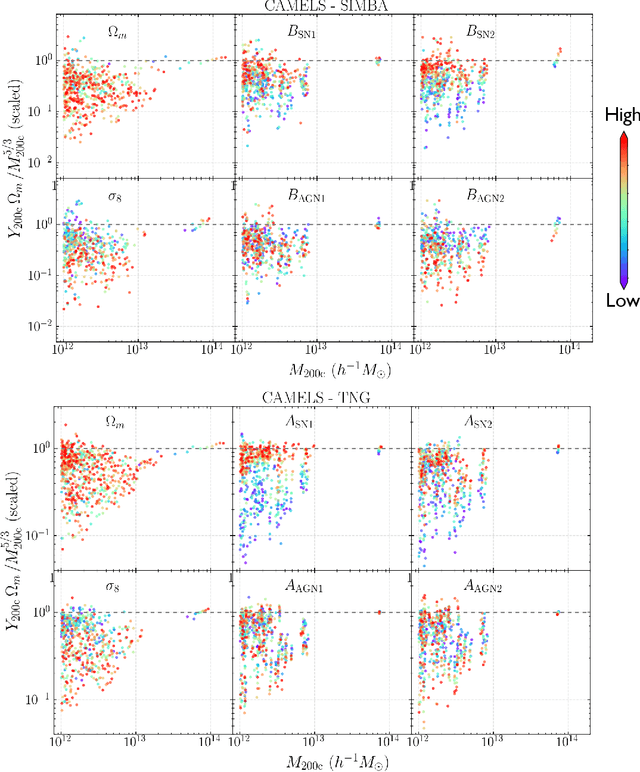
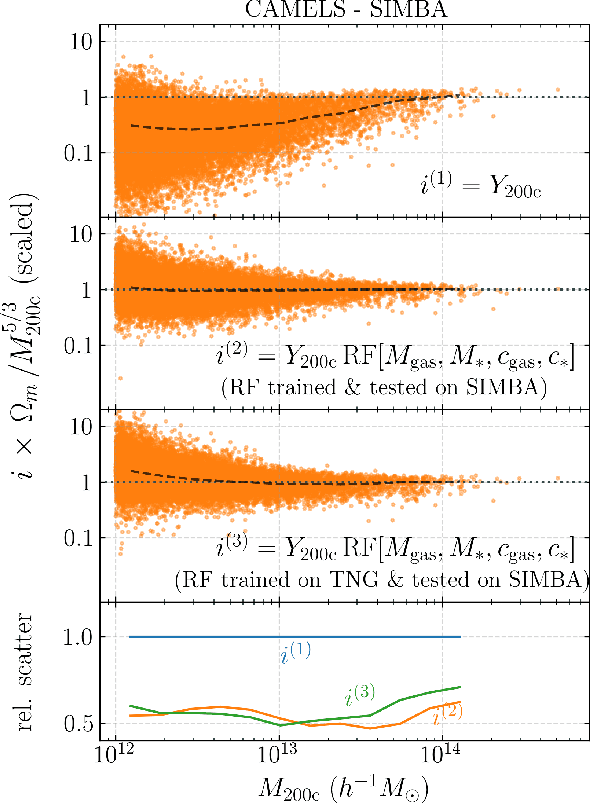

Abstract:Ionized gas in the halo circumgalactic medium leaves an imprint on the cosmic microwave background via the thermal Sunyaev-Zeldovich (tSZ) effect. Feedback from active galactic nuclei (AGN) and supernovae can affect the measurements of the integrated tSZ flux of halos ($Y_\mathrm{SZ}$) and cause its relation with the halo mass ($Y_\mathrm{SZ}-M$) to deviate from the self-similar power-law prediction of the virial theorem. We perform a comprehensive study of such deviations using CAMELS, a suite of hydrodynamic simulations with extensive variations in feedback prescriptions. We use a combination of two machine learning tools (random forest and symbolic regression) to search for analogues of the $Y-M$ relation which are more robust to feedback processes for low masses ($M\lesssim 10^{14}\, h^{-1} \, M_\odot$); we find that simply replacing $Y\rightarrow Y(1+M_*/M_\mathrm{gas})$ in the relation makes it remarkably self-similar. This could serve as a robust multiwavelength mass proxy for low-mass clusters and galaxy groups. Our methodology can also be generally useful to improve the domain of validity of other astrophysical scaling relations. We also forecast that measurements of the $Y-M$ relation could provide percent-level constraints on certain combinations of feedback parameters and/or rule out a major part of the parameter space of supernova and AGN feedback models used in current state-of-the-art hydrodynamic simulations. Our results can be useful for using upcoming SZ surveys (e.g. SO, CMB-S4) and galaxy surveys (e.g. DESI and Rubin) to constrain the nature of baryonic feedback. Finally, we find that the an alternative relation, $Y-M_*$, provides complementary information on feedback than $Y-M$.
Augmenting astrophysical scaling relations with machine learning : application to reducing the SZ flux-mass scatter
Jan 17, 2022



Abstract:Complex systems (stars, supernovae, galaxies, and clusters) often exhibit low scatter relations between observable properties (e.g., luminosity, velocity dispersion, oscillation period, temperature). These scaling relations can illuminate the underlying physics and can provide observational tools for estimating masses and distances. Machine learning can provide a systematic way to search for new scaling relations (or for simple extensions to existing relations) in abstract high-dimensional parameter spaces. We use a machine learning tool called symbolic regression (SR), which models the patterns in a given dataset in the form of analytic equations. We focus on the Sunyaev-Zeldovich flux$-$cluster mass relation ($Y_\mathrm{SZ}-M$), the scatter in which affects inference of cosmological parameters from cluster abundance data. Using SR on the data from the IllustrisTNG hydrodynamical simulation, we find a new proxy for cluster mass which combines $Y_\mathrm{SZ}$ and concentration of ionized gas ($c_\mathrm{gas}$): $M \propto Y_\mathrm{conc}^{3/5} \equiv Y_\mathrm{SZ}^{3/5} (1-A\, c_\mathrm{gas})$. $Y_\mathrm{conc}$ reduces the scatter in the predicted $M$ by $\sim 20-30$% for large clusters ($M\gtrsim 10^{14}\, h^{-1} \, M_\odot$) at both high and low redshifts, as compared to using just $Y_\mathrm{SZ}$. We show that the dependence on $c_\mathrm{gas}$ is linked to cores of clusters exhibiting larger scatter than their outskirts. Finally, we test $Y_\mathrm{conc}$ on clusters from simulations of the CAMELS project and show that $Y_\mathrm{conc}$ is robust against variations in cosmology, astrophysics, subgrid physics, and cosmic variance. Our results and methodology can be useful for accurate multiwavelength cluster mass estimation from current and upcoming CMB and X-ray surveys like ACT, SO, SPT, eROSITA and CMB-S4.
The CAMELS project: public data release
Jan 04, 2022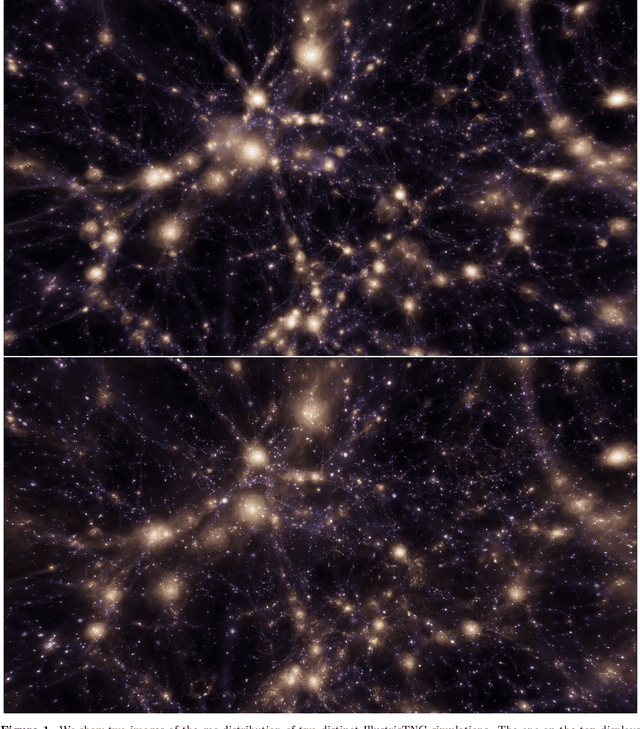
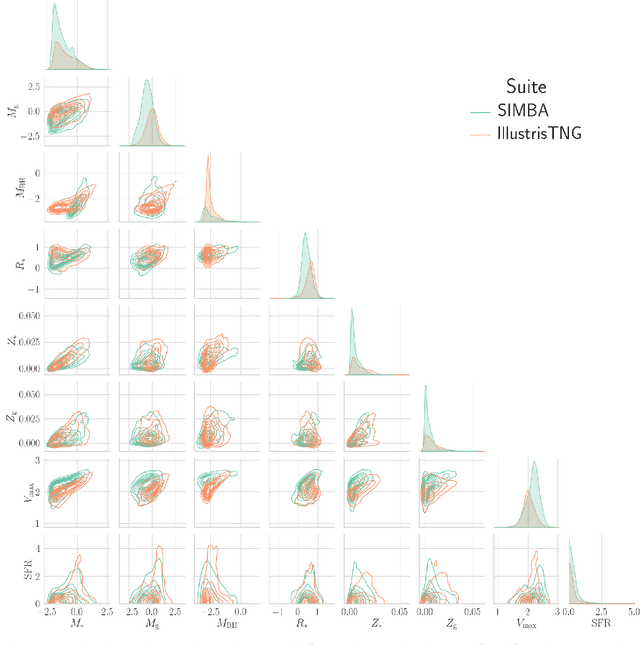
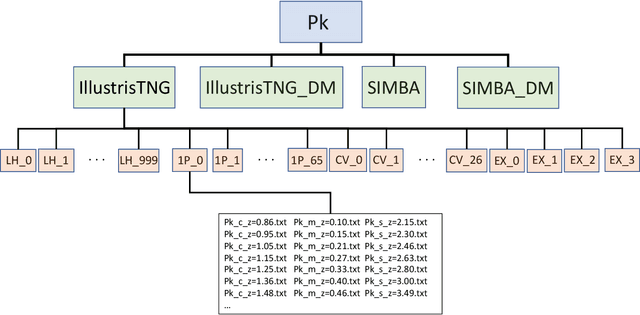
Abstract:The Cosmology and Astrophysics with MachinE Learning Simulations (CAMELS) project was developed to combine cosmology with astrophysics through thousands of cosmological hydrodynamic simulations and machine learning. CAMELS contains 4,233 cosmological simulations, 2,049 N-body and 2,184 state-of-the-art hydrodynamic simulations that sample a vast volume in parameter space. In this paper we present the CAMELS public data release, describing the characteristics of the CAMELS simulations and a variety of data products generated from them, including halo, subhalo, galaxy, and void catalogues, power spectra, bispectra, Lyman-$\alpha$ spectra, probability distribution functions, halo radial profiles, and X-rays photon lists. We also release over one thousand catalogues that contain billions of galaxies from CAMELS-SAM: a large collection of N-body simulations that have been combined with the Santa Cruz Semi-Analytic Model. We release all the data, comprising more than 350 terabytes and containing 143,922 snapshots, millions of halos, galaxies and summary statistics. We provide further technical details on how to access, download, read, and process the data at \url{https://camels.readthedocs.io}.
Weighing the Milky Way and Andromeda with Artificial Intelligence
Nov 29, 2021



Abstract:We present new constraints on the masses of the halos hosting the Milky Way and Andromeda galaxies derived using graph neural networks. Our models, trained on thousands of state-of-the-art hydrodynamic simulations of the CAMELS project, only make use of the positions, velocities and stellar masses of the galaxies belonging to the halos, and are able to perform likelihood-free inference on halo masses while accounting for both cosmological and astrophysical uncertainties. Our constraints are in agreement with estimates from other traditional methods.
Inferring halo masses with Graph Neural Networks
Nov 16, 2021

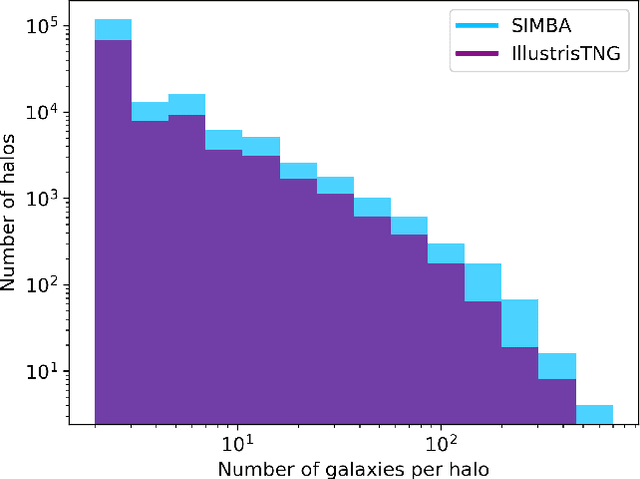
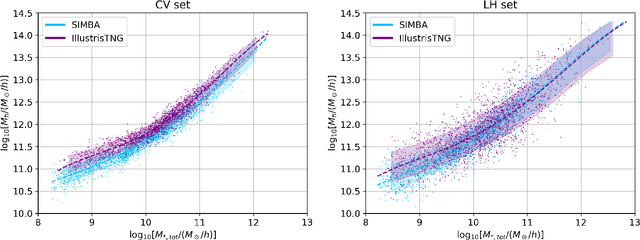
Abstract:Understanding the halo-galaxy connection is fundamental in order to improve our knowledge on the nature and properties of dark matter. In this work we build a model that infers the mass of a halo given the positions, velocities, stellar masses, and radii of the galaxies it hosts. In order to capture information from correlations among galaxy properties and their phase-space, we use Graph Neural Networks (GNNs), that are designed to work with irregular and sparse data. We train our models on galaxies from more than 2,000 state-of-the-art simulations from the Cosmology and Astrophysics with MachinE Learning Simulations (CAMELS) project. Our model, that accounts for cosmological and astrophysical uncertainties, is able to constrain the masses of the halos with a $\sim$0.2 dex accuracy. Furthermore, a GNN trained on a suite of simulations is able to preserve part of its accuracy when tested on simulations run with a different code that utilizes a distinct subgrid physics model, showing the robustness of our method. The PyTorch Geometric implementation of the GNN is publicly available on Github at https://github.com/PabloVD/HaloGraphNet
Multifield Cosmology with Artificial Intelligence
Sep 20, 2021
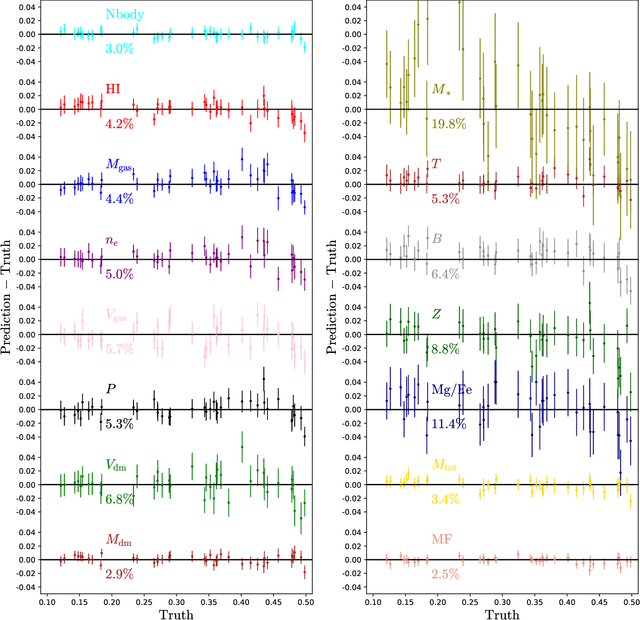
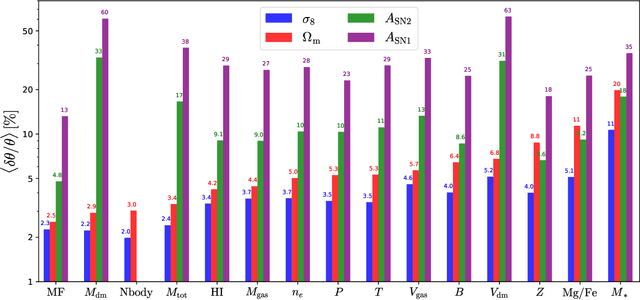

Abstract:Astrophysical processes such as feedback from supernovae and active galactic nuclei modify the properties and spatial distribution of dark matter, gas, and galaxies in a poorly understood way. This uncertainty is one of the main theoretical obstacles to extract information from cosmological surveys. We use 2,000 state-of-the-art hydrodynamic simulations from the CAMELS project spanning a wide variety of cosmological and astrophysical models and generate hundreds of thousands of 2-dimensional maps for 13 different fields: from dark matter to gas and stellar properties. We use these maps to train convolutional neural networks to extract the maximum amount of cosmological information while marginalizing over astrophysical effects at the field level. Although our maps only cover a small area of $(25~h^{-1}{\rm Mpc})^2$, and the different fields are contaminated by astrophysical effects in very different ways, our networks can infer the values of $\Omega_{\rm m}$ and $\sigma_8$ with a few percent level precision for most of the fields. We find that the marginalization performed by the network retains a wealth of cosmological information compared to a model trained on maps from gravity-only N-body simulations that are not contaminated by astrophysical effects. Finally, we train our networks on multifields -- 2D maps that contain several fields as different colors or channels -- and find that not only they can infer the value of all parameters with higher accuracy than networks trained on individual fields, but they can constrain the value of $\Omega_{\rm m}$ with higher accuracy than the maps from the N-body simulations.
 Add to Chrome
Add to Chrome Add to Firefox
Add to Firefox Add to Edge
Add to Edge